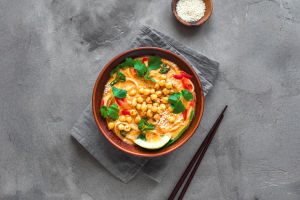Pesto Pasta Perfected
Pesto pasta is a favorite dish for many of us. The bright green sauce made from basil, garlic, pine nuts, and olive oil is both vibrant and flavorful. But here's the thing: sometimes it can feel a little too rich and greasy.
If you've ever made pesto at home and found that it's a bit too oily for your taste, you're not alone! But don't worry, we've got you covered with some simple tips to lighten it up without losing the delicious flavors.
1. Lighten the Olive Oil
The main culprit behind greasy pesto pasta is often the olive oil. While olive oil is delicious and necessary for the pesto's texture, too much can make the dish feel heavy. To reduce the oiliness, try using less olive oil in your pesto sauce. You can also opt for a lighter olive oil or mix it with a little bit of water to achieve the same creamy texture without the excess grease.
2. Add Fresh Greens
A great way to balance out the richness of pesto is by adding more greens! We can all agree that more veggies are never a bad thing. You can add spinach, kale, or even arugula to your pesto sauce to lighten its texture and add a burst of freshness. These greens will still blend well with the basil but won't overpower the flavor.
3. Use a Small Amount of Parmesan
Parmesan cheese can add a lovely umami flavor to pesto pasta, but it can also contribute to the heaviness. Instead of loading your pesto with cheese, try adding a small amount and blending it in. You'll still get the flavor boost without going overboard. Alternatively, you can mix in a little nutritional yeast if you're looking for a vegan option that still has a cheesy flavor.
4. Incorporate Lemon Zest or Juice
One of the simplest ways to cut through the richness of pesto is by adding some acidity. A little bit of lemon juice or lemon zest can work wonders in balancing out the oiliness. The bright, fresh taste of lemon will add a refreshing contrast and keep the pesto from feeling too heavy. Just a teaspoon of lemon juice is enough to lift the dish.
5. Go Easy on the Nuts
Pine nuts are a classic ingredient in pesto, but they can also contribute to a heavier texture. Instead of using a large amount of pine nuts, try reducing the quantity or even swapping them out for a lighter alternative like sunflower seeds or walnuts. These nuts will still give you that rich, nutty flavor without the extra heaviness.
6. Cook the Pasta Just Right
When making pesto pasta, cooking the pasta properly is essential. If your pasta is too soft, it will soak up more of the sauce and make it feel even greasier. Be sure to cook the pasta al dente—firm, but tender. This helps the sauce coat the pasta evenly without excess oil pooling at the bottom of the plate.
7. Use a Light Pesto Version
If you're really looking to reduce the richness, consider making a lighter pesto sauce altogether. Try substituting part of the olive oil with Greek yogurt or even silken tofu to make a creamy pesto sauce that's not as oily. Blending in some fresh herbs like parsley or mint can add more flavor without the extra oil.
Conclusion: Enjoy a Lighter, Fresher Pesto Pasta!
With these easy adjustments, we can enjoy a lighter, fresher pesto pasta that still packs all the delicious flavors we love. By playing around with the ingredients and making small tweaks to the recipe, you'll find the perfect balance that works for you. So next time you're craving that bright, herbaceous pesto pasta, give these tips a try and enjoy a dish that's rich in flavor, but not greasy. Happy cooking!
Let us know in the comments if you've tried any of these tips or have other ways to lighten up your pesto pasta!
-
 Perfect Snack PairingsFrom Crunchy to Sweet: Irresistible Snacks for Your Binge Nights
Perfect Snack PairingsFrom Crunchy to Sweet: Irresistible Snacks for Your Binge Nights -
 Bright Lemon DelightYou Won’t Believe How Easy This French Lemon Tart Is—It’s Tangy, Silky, and Absolutely Gorgeous!
Bright Lemon DelightYou Won’t Believe How Easy This French Lemon Tart Is—It’s Tangy, Silky, and Absolutely Gorgeous! -
 Spicy Noodle ComfortYou Won’t Believe This Creamy Vegetarian Laksa Soup Takes Just 30 Minutes
Spicy Noodle ComfortYou Won’t Believe This Creamy Vegetarian Laksa Soup Takes Just 30 Minutes
Copyright © zogu 2021 - 2025. All Right Reserved.